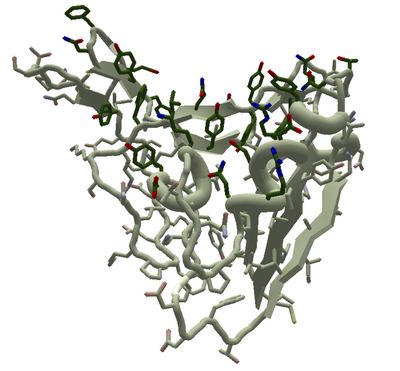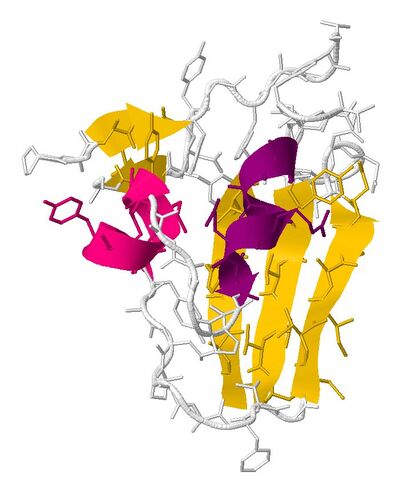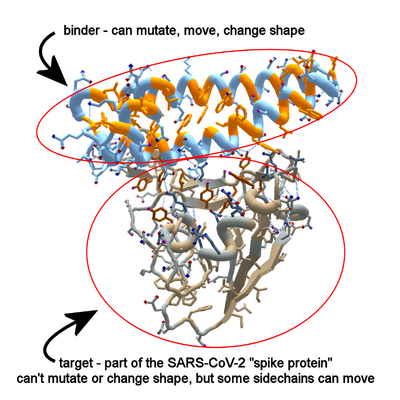
The Coronavirus Spike Protein from SARS-CoV-2, as seen in puzzle 1805b. The spike's binding site is along the curved "groove" at the top. The green sidechains are unlocked, and can move. The rest of the protein is locked, appearing in the shade of gray. (EnzDes coloring.)
The Coronavirus Spike Protein is found on the surface of a coronavirus. This protein allows the virus to bind to specific receptors on the surface of a human cell, the first step toward infecting the cell.
In Foldit, a series of puzzles have targeted the spike protein from SARS-CoV-2, the coronavirus that causes COVID-19.
See Coronavirus Binder Design for a complete list of these puzzles.
The blog post Coronavirus designs queued for testing! describes testing for 33 designs from the first three rounds of the spike protein puzzles.
The description for puzzle 1805b states:
If we can design a protein that binds to this coronavirus spike protein, it could be used to block the interaction with human cells and halt infection!
The coronavirus puzzles are an example of a Foldit binder puzzle. All the coronavirus puzzles have two separate protein chains. The first chain is the spike protein, the target, and the second chain can be freely designed by players to make a binder that fits the target.
The more recent puzzles in the series have included new binder metrics that measure the quality of the interface between the binder and the target.
Spike Protein[]

The portion of the A chain of PDB 6VSB that corresponds to the target of Foldit puzzle 1805b, as seen in Jmol.
The first chain in the coronavirus puzzle is the spike protein. It appears as segments 1 to 117 in Foldit. This chain is mostly locked, so it will maintain its overall shape. The first chain does have many unlocked sidechains on the "binding site", the area where the spike attaches to a human cell.
Using view options like CPK or EnzDes coloring and "show all sidechains", the locked backbone and sidechains appear in light gray, while the moveable sidechains will be either dark gray (CPK) or green (EnzDes), highlighted with red oxygen atoms and blue nitrogen atoms.
Many of the unlocked sidechains on the spike protein are polar, meaning they have oxygen and nitrogen atoms that can form hydrogen bonds. A successful design should make as many hydrogen bonds as possible with these polar atoms, "satisfying" them, and reducing the overall "free energy".
The spike protein binding site has a curved "groove", which contains the moveable sidechains. A successful design would fill this groove, eliminating most voids.
The spike protein in the coronavirus puzzles matches 6VSB in the PDB. 6VSB is a trimer, and the Foldit spike protein matches all three chains.
Segment 1 in Foldit is residue 397 of each chain in 6VSB. The Foldit protein is only a small portion of the entire spike. The three chains of 6VSB each have 1,288 residues, so the target in the coronavirus puzzles is less than 10% of a single chain.
In addition to 6VSB, the Foldit spike protein target also matches several other "spike glycoproteins" in the PDB, such as 3SCI, but these matches are much weaker, with exact matches to only 75 or 76 of the 117 segments in Foldit.
As detailed in Chemical and Engineering News, a team at the University of Texas - Austin, used knowledge of other coronaviruses to quickly determine the structure of COVID-19. The resulting paper was rushed through the peer review process an published in Science on 19 February 2020, only months after the virus was first detected.
A team from Tsinghua University in Beijing has also determined the structure of the spike protein bound to its ACE2 target. A pre-print version of their paper is available. The starting pose of the coronavirus beginner puzzle is based on these results.
Binder Protein[]

The Coronavirus beginner puzzle showing the spike protein target and the pre-designed binder.
The second protein chain in the coronavirus puzzles is intended to be the binder that attaches to the spike protein.
In the beginner coronavirus puzzle, the binder protein starts with a design which players can work to improve. The amino acid sequence or primary structure, secondary structure, and overall shape or tertiary structure are based on human ACE2, an enzyme found on the surface of many types of cells. ACE2 is the point where coronavirus binds to cells.
In the other coronavirus puzzles (identified as "intermediate" difficulty), the binder design section starts as a straight extended chain, consisting of 75 isoleucine segments. Players can add up to 10 additional segments, but there's a "Residue Count" filter (condition) that subtracts 55 points for each added segment (residue).
Players can also add up to 10 segments in the beginner coronavirus puzzle. In beginner puzzle, there's no penalty for adding segments.
In all versions of the coronavirus puzzle, players can use all the Foldit tools to design the second chain, such as Mutate, Blueprint, the Rama Map, Move, and the ever-popular Shake and Wiggle. As with many recent design puzzles, the Rebuild tool is disabled, but the Remix tool is of course available.
All Foldit recipes can be used freely when designing the binder. (Not all recipes pay attention to locked segments, however, so they may waste time trying to change the locked target section containing the spike protein.)